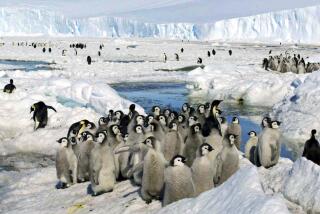Penguin poop shows colonies thrived in Antarctica Little Ice Age
- Share via
A three-century record of penguin poop shows that the flightless birds probably thrived during the Little Ice Age, a Chinese research team says.
Contrary to some reports that the Adelie penguin fared better in warmer conditions, when sea ice broke up, Earth scientist Zhou-Quing Xie of the University of Science and Technology in Hefei, China, says that from 1490 to 1670, the middle of the so-called Little Ice Age, Adelies thrived on Ross Island off the coast of Antarctica.
The penguins, in fact, pushed out seals as the dominant species around the beginning of the three-century cooling period, when summertime temperatures were about 4 degrees Fahrenheit colder than in the last couple centuries, according to a study Xie’s team published Thursday in Scientific Reports.
The penguins likely were favored by sea ice that spurred the growth of algae, a food source for the krill on which the penguins feed, the researchers concluded. Prevailing winds also tended to create breaches in the ice to give the birds access to the waters, the team concluded.
Xie’s team scooped samples from guano piled more than 3 feet deep and measured such chemical markers as cholesterol and cholestanol to correlate them with penguin populations. They also measured evidence of algae, which depends on nutrients in penguin guano, and lichens, which tend to be trampled by the birds.
They found the area was mostly a seal haul-out and molting site from around 1280 to the time Columbus sailed the seas, when this far-south area of the continent began to support an increasing abundance of Adelie penguins.
Notably, Xie said, penguin colonies have appeared and disappeared repeatedly around the Ross Island area over the last 8,000 years, suggesting the species is adaptable to climate changes.
Results from the study, Xie said, show that predictions about the fate of the Adelies as climate shifts may prove difficult. Their population has declined over the last four decades, as temperatures have climbed, he noted. But their populations have been adept at migration, he suggested.
“The behaviors for different species of penguin are different, even for populations of the same species, which may be different under different living conditions,” Xie said.
The fate of penguin species in warming times, however, remains perilous, according to other studies. Most predict a continued steep decline in the population of larger Emperor penguins and the smaller Adelies. Last year, the Woods Hole Oceanographic Institution predicted that Emperors would disappear from areas of eastern Antarctica because of vanishing sea ice.






